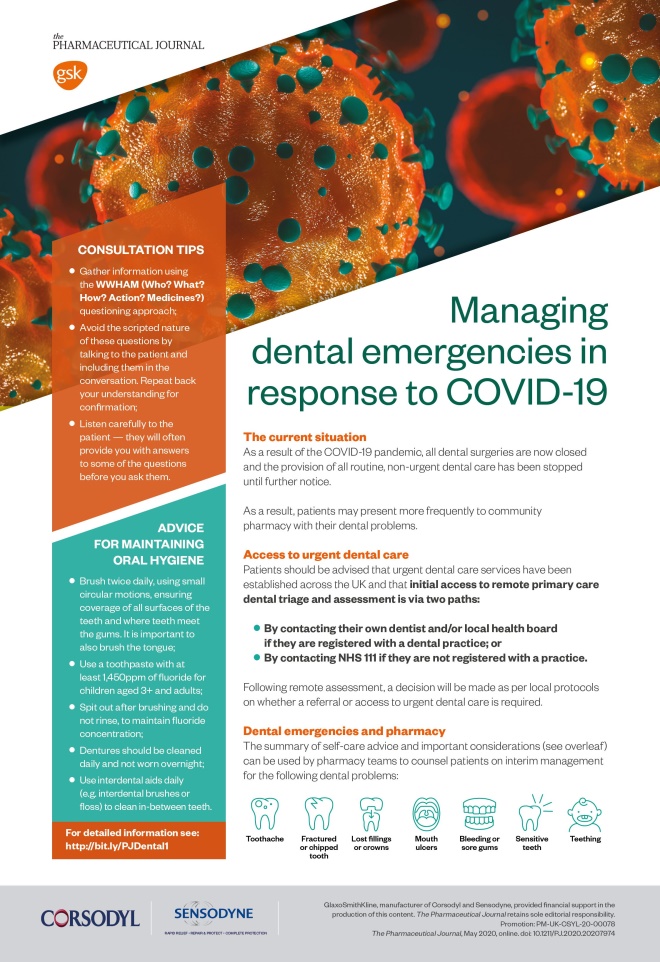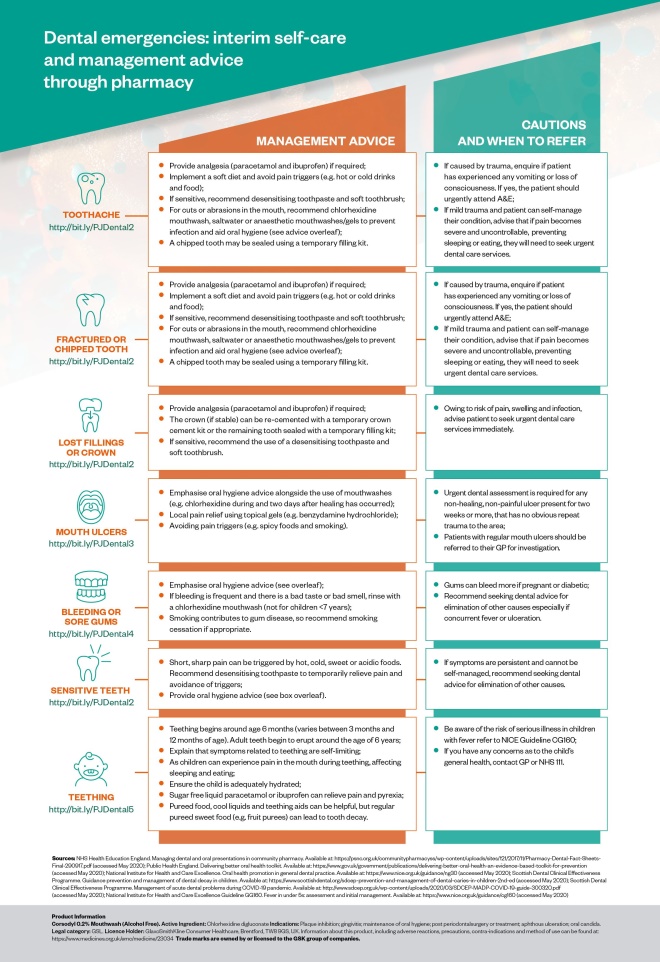
Shutterstock.com
The current situation
As a result of the COVID-19 pandemic, all dental surgeries are now closed and the provision of all routine, non-urgent dental care has been stopped until further notice.
As a result, patients may present more frequently to community pharmacy with their dental problems.
Access to urgent dental care
Patients should be advised that urgent dental care services have been established across the UK and that initial access to remote primary care dental triage and assessment is via two paths:
- By contacting their own dentist and/or local health board if they are registered with a dental practice; or
- By contacting NHS 111 if they are not registered with a practice.
Following remote assessment, a decision will be made as per local protocols on whether a referral or access to urgent dental care is required.
Dental emergencies and pharmacy
The summary of self-care advice and important considerations (see PDF below), can be used by pharmacy teams to counsel patients on interim management for the following dental problems:
- Toothache;
- Fractured or chipped tooth;
- Lost fillings or crowns;
- Mouth ulcers;
- Bleeding or sore gums;
- Sensitive teeth;
- Teething.


Download a PDF of the help sheet here
.
For information on consultation tips and how to advise patients on maintaining oral hygiene, see Boxes 1 and 2.
Box 1: Consultation tips
- Gather information using the WWHAM (Who? What? How? Action? Medicines?) questioning approach;
- Avoid the scripted nature of these questions by talking to the patient and including them in the conversation. Repeat back your understanding for confirmation;
- Listen carefully to the patient — they will often provide you with answers to some of the questions before you ask them.
Box 2: Advice for maintaining oral hygiene
- Brush twice daily, using small circular motions, ensuring coverage of all surfaces of the teeth and where teeth meet the gums. It is important to also brush the tongue;
- Use a toothpaste with at least 1,450ppm of fluoride for children aged three years and older and adults;
- Spit out after brushing and do not rinse, to maintain fluoride concentration;
- Dentures should be cleaned daily and not worn overnight;
- Use interdental aids daily (e.g. interdental brushes or floss) to clean in-between teeth.
Find more detailed information on oral hygiene here.
Product Information
Corsodyl 0.2% Mouthwash (Alcohol Free).
Active ingredient: Chlorhexidine digluconate Indications: Plaque inhibition; gingivitis; maintenance of oral hygiene; post periodontalsurgery or treatment; aphthous ulceration; oral candida. Legal category: GSL Licence holder: GlaxoSmithKline Consumer Healthcare, Brentford, TW8 9GS, U.K. Information about this product, including adverse reactions, precautions, contra-indications and method of use can be found at: https://www.medicines.org.uk/emc/medicine/23034
Trade marks are owned by or licensed to the GSK group of companies.
Promotion: PM-UK-CSYL-20-00078
References
1. NHS Health Education England. Managing dental and oral presentations in community pharmacy. 2017. Available at: https://psnc.org.uk/communitypharmacyss/wp-content/uploads/sites/121/2017/11/Pharmacy-Dental-Fact-Sheets-Final-290917.pdf (accessed May 2020)
2. Public Health England. Delivering better oral health toolkit. 2017. Available at: https://www.gov.uk/government/publications/delivering-better-oral-health-an-evidence-based-toolkit-for-prevention (accessed May 2020)
3. National Institute for Health and Care Excellence. Oral health promotion in general dental practice. 2015. Available at: https://www.nice.org.uk/guidance/ng30 (accessed May 2020)
4. Scottish Dental Clinical Effectiveness Programme. Guidance prevention and management of dental decay in children. 2018. Available at: https://www.scottishdental.org/sdcep-prevention-and-management-of-dental-caries-in-children-2nd-ed (accessed May 2020)
5. Scottish Dental Clinical Effectiveness Programme. Management of acute dental problems during COVID-19 pandemic. 2020. Available at: http://www.sdcep.org.uk/wp-content/uploads/2020/03/SDCEP-MADP-COVID-19-guide-300320.pdf (accessed May 2020)
6. National Institute for Health and Care Excellence Guideline GG160. Fever in under 5s: assessment and initial management. 2013. Available at: https://www.nice.org.uk/guidance/cg160 (accessed May 2020)
You may also be interested in
The importance of diverse clinical imagery within health education

Government should consider ways to prevent ‘inappropriate overseas prescribing’ of hormone drugs, review recommends

